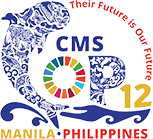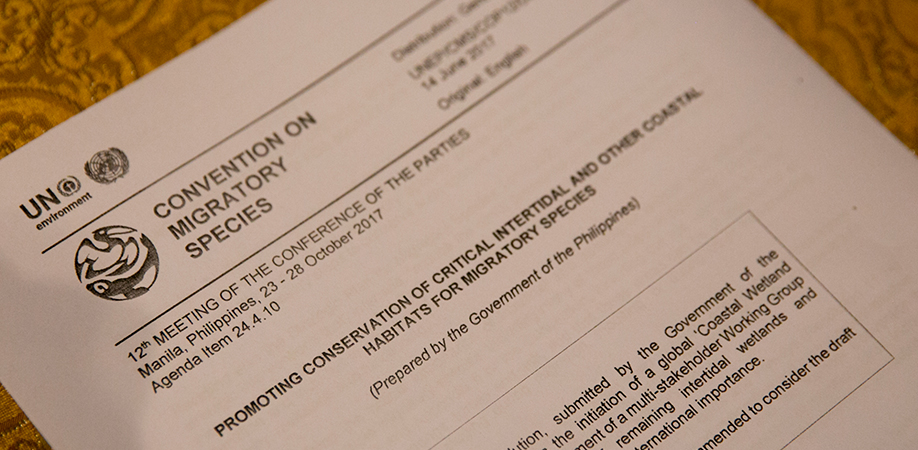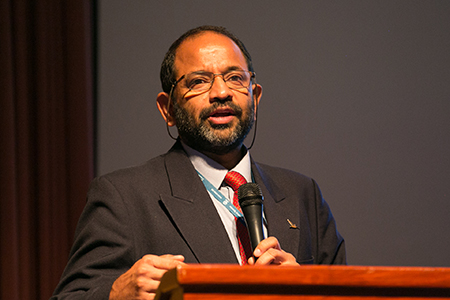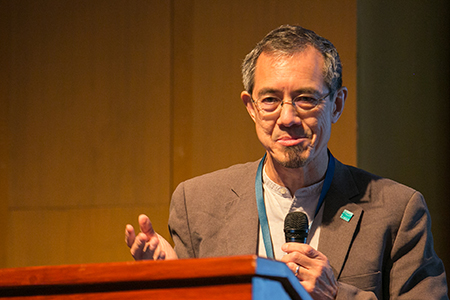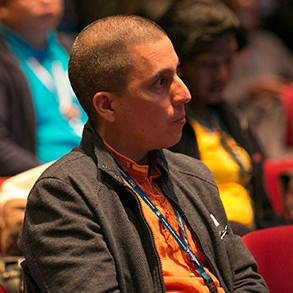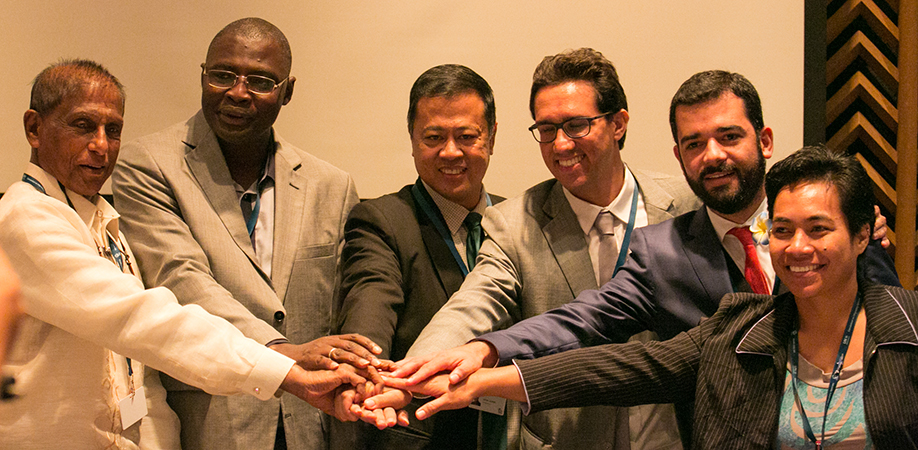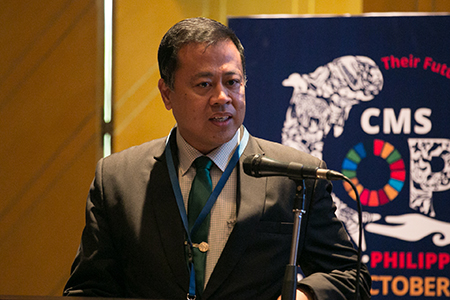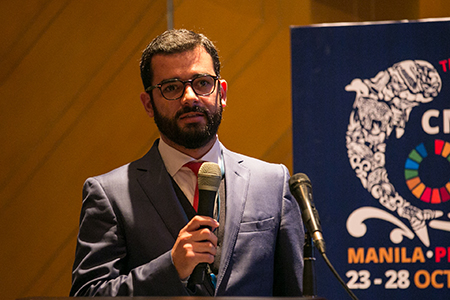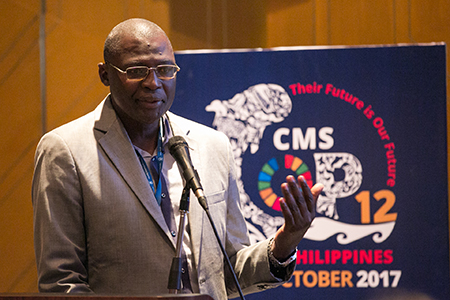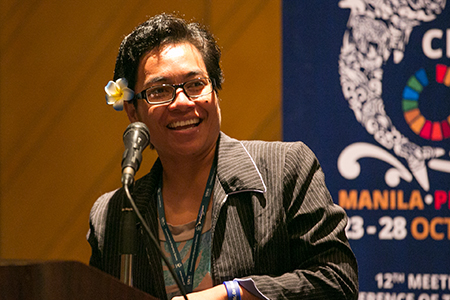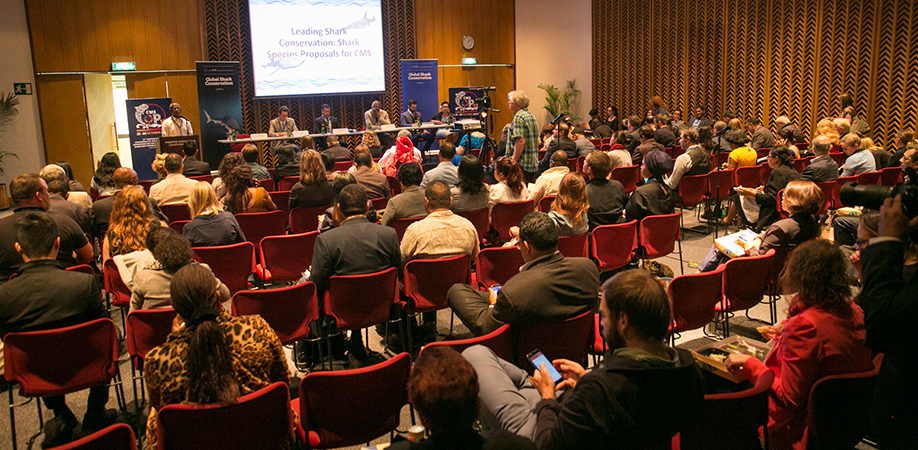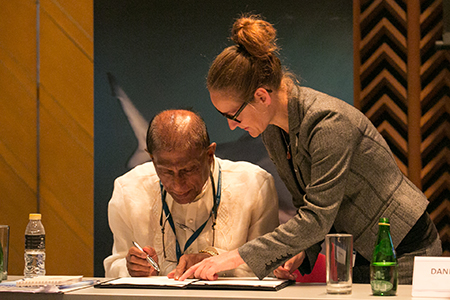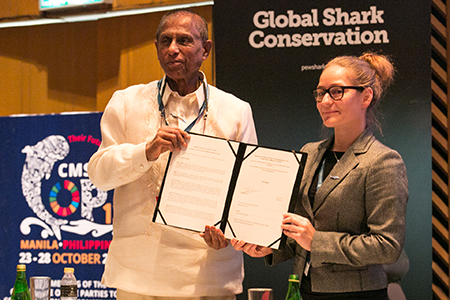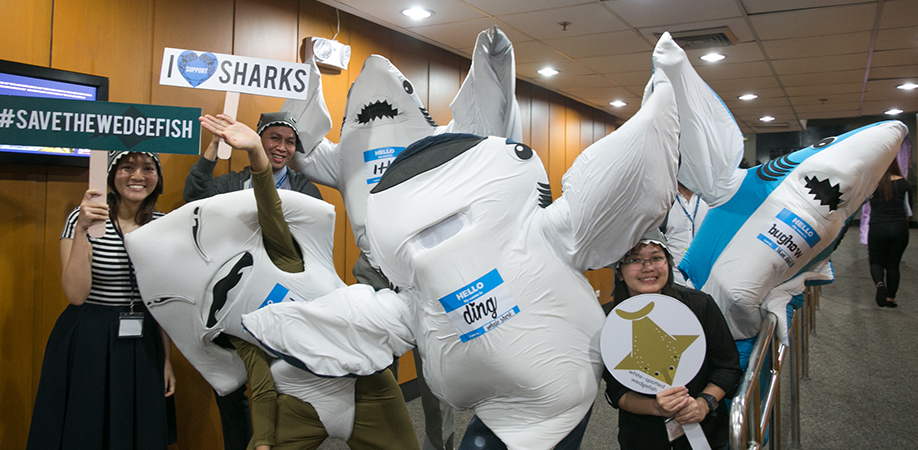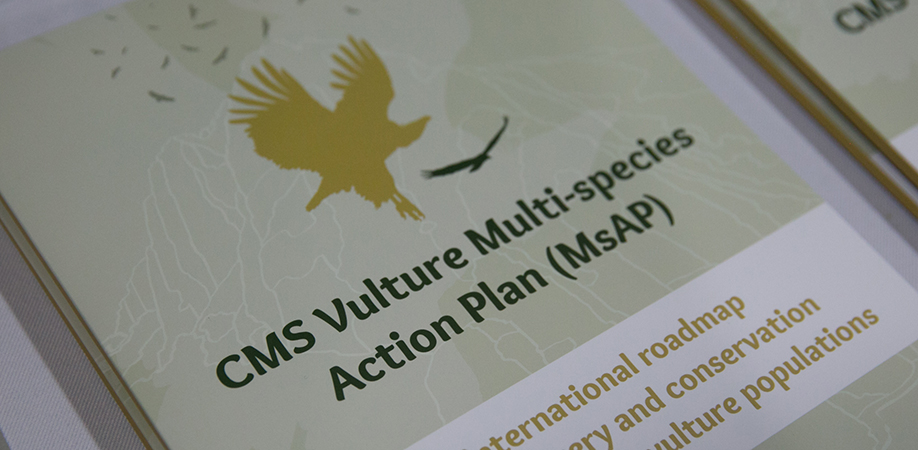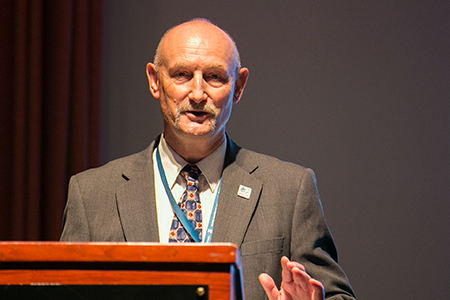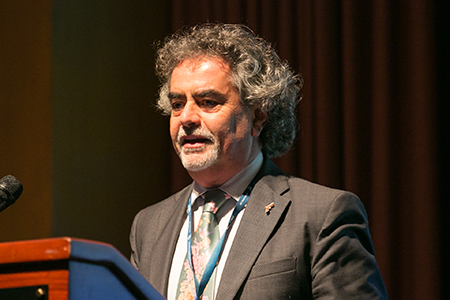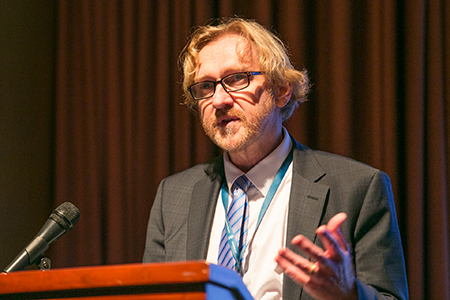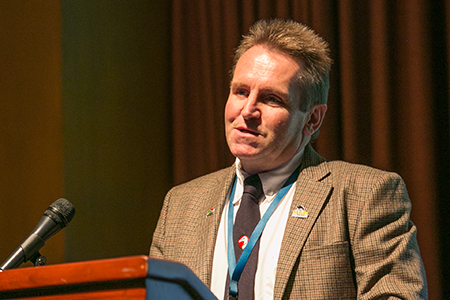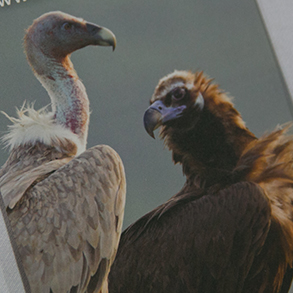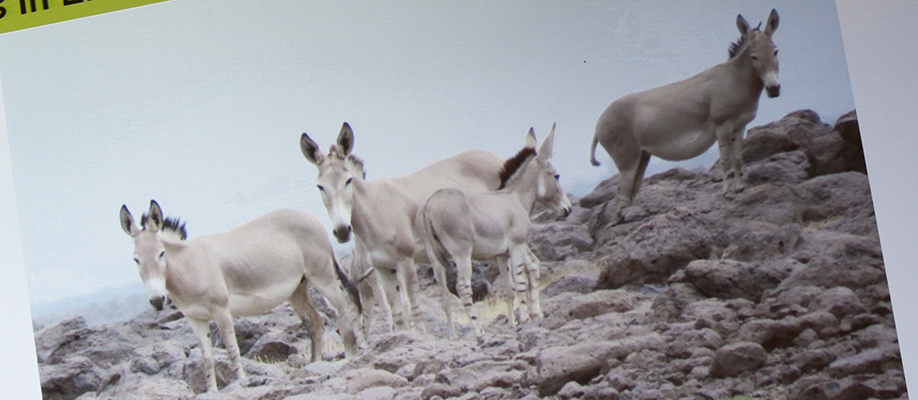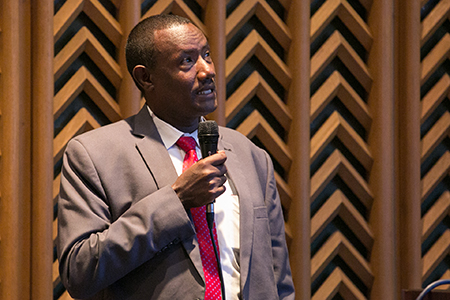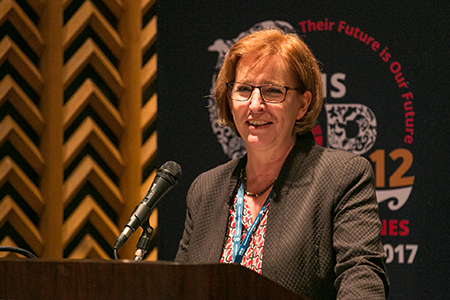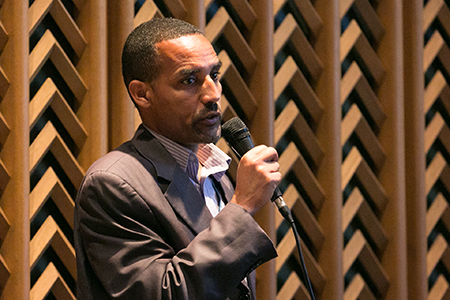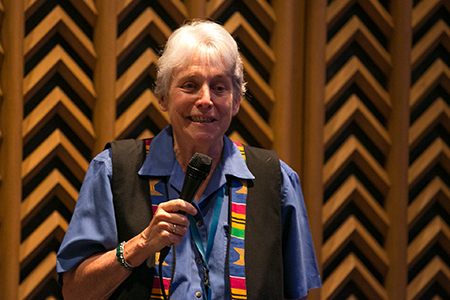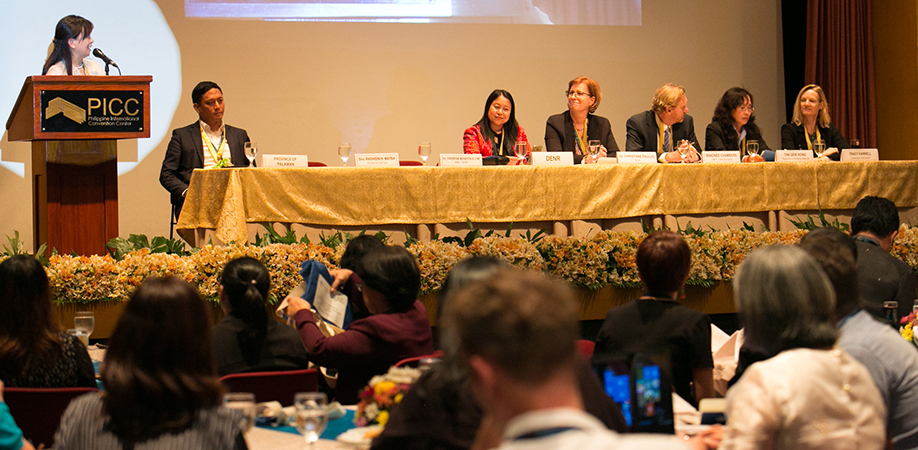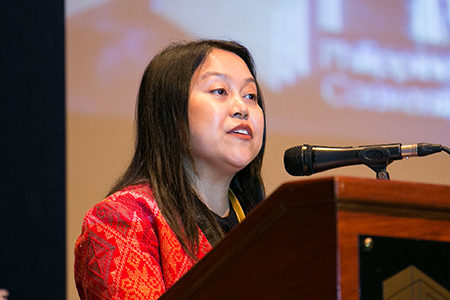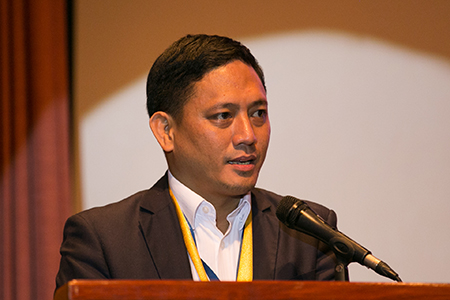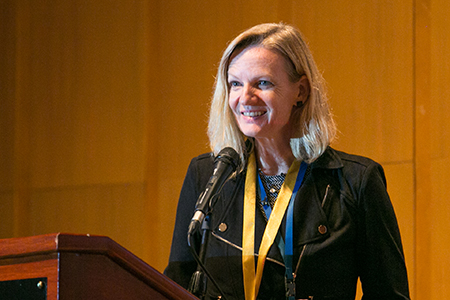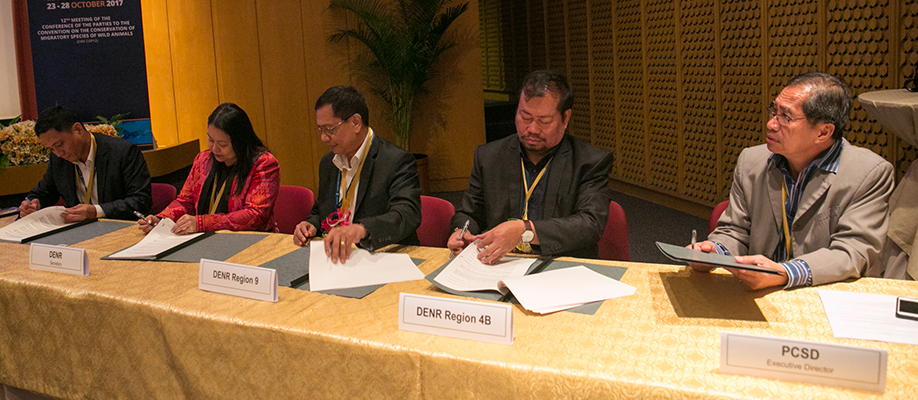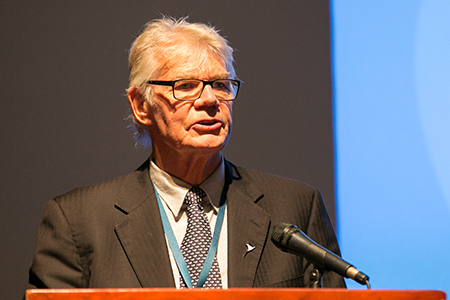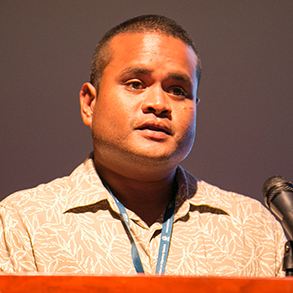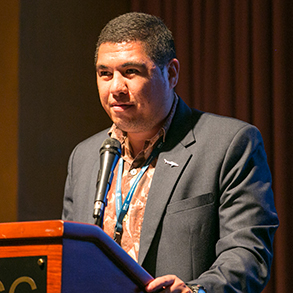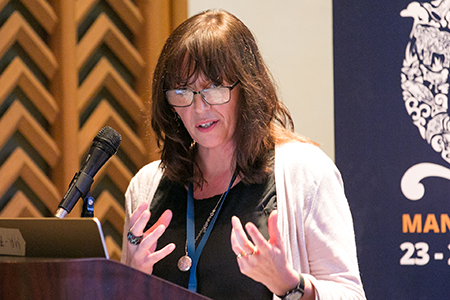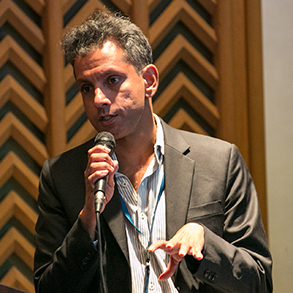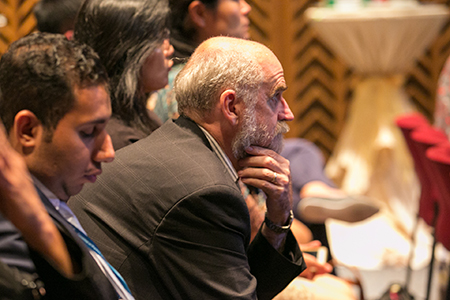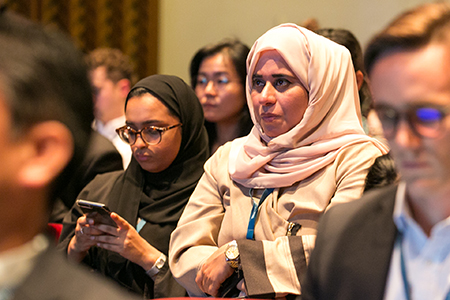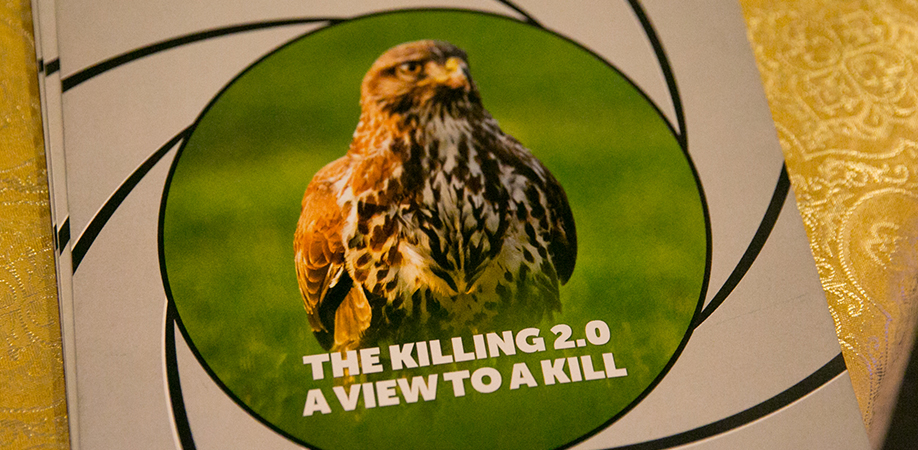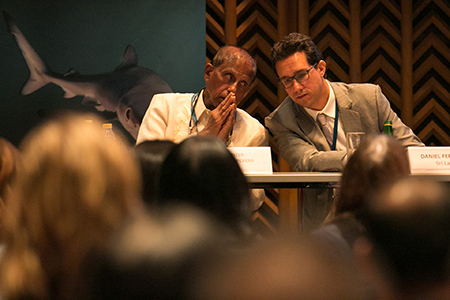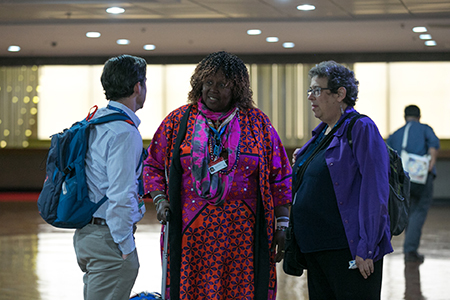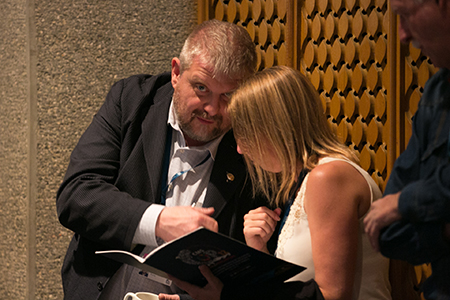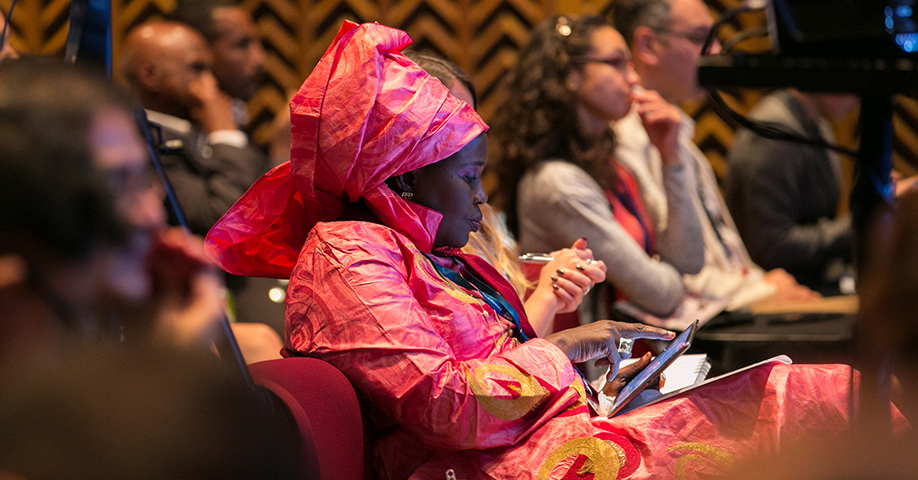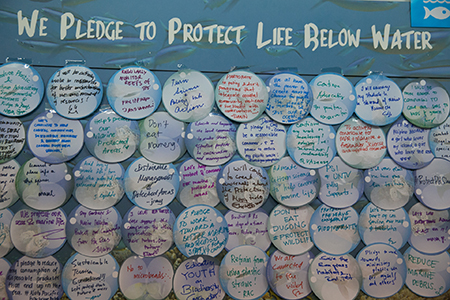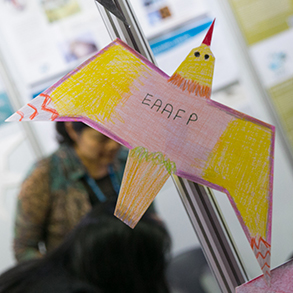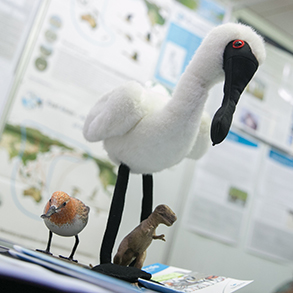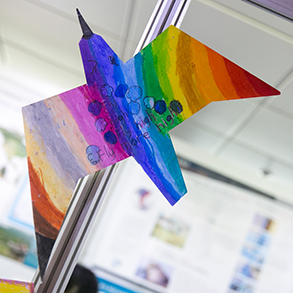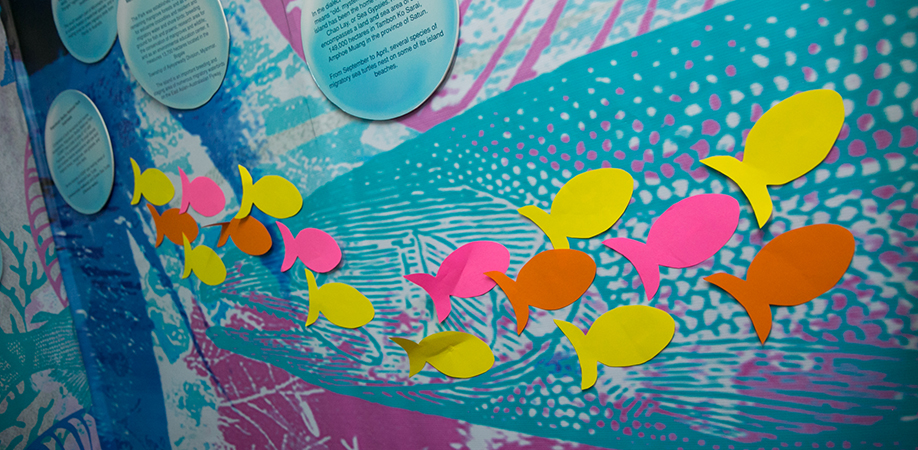Summary
The following events were covered by IISD Reporting Services on Tuesday, 24 October 2017:
- Promoting Conservation of Critical Intertidal and other Coastal Habitats for Migratory Species
- Leading Shark Conservation: Shark Species Proposals for CMS
- Conserving African- Eurasian Vultures for Biodiversity and Ecosystem Services: the Role of the Multi- Species Action Plan
- Roadmap for the Conservation of the African Wild Ass
- Establishing a Network of Safe Havens for Green Turtle, Chelonia mydas, in Sulu- Sulawesi Seascape
- Year of the Whale in the Pacific Islands – Whales in a Changing Ocean
- CMS and Partner Action and Plans for Stopping Illegal Killing/Hunting, Taking and Trade of Migratory Birds
IISD Reporting Services, through its Earth Negotiations Bulletin on the Side (ENBOTS) Meeting Coverage, is providing daily web coverage from selected side events at CMS COP12.
Photos by IISD/ENB | Kiara Worth
For photo reprint permissions, please follow instructions at our Attribution Regulations for Meeting Photo Usage Page.
Promoting Conservation of Critical Intertidal and other Coastal Habitats for Migratory SpeciesPresented by the Government of the Philippines, Ramsar Secretariat, Wetlands International,
and BirdLife International
This event focused on migratory species at risk from coastal habitat degradation, good conservation and management practices, a global initiative for conservation and restoration, and elements of the proposed relevant CMS resolution.
Introducing the event, Annadel Cabanban, Wetlands International, said that wetlands are declining at a rate of 1% per year, with a multiplier effect on coastal ecosystems.
Taej Mundkur, Wetlands International, noted that over 300 CMS-listed species are dependent on coastal habitats. Citing examples of shorebirds, the Mediterranean monk seal, dugong, turtles, rays, dolphins and other species, he emphasized coastal habitat use for feeding, resting, and breeding, and impacts from development, recreation, fishing, and legal and illegal sales.
Lew Young, Ramsar Secretariat, emphasized the need to consider and manage for the full range of benefits provided by coastal ecosystems. He noted that 32 of 53 Ramsar sites in the Association of Southeast Asian Nations (ASEAN) region have coastal components, with 90 percent of those providing food for local people. He highlighted land-use planning as a conservation tool, including the need to consider threats from areas adjacent to protected sites.
Ding Li Yong, BirdLife International, described a global restoration initiative ‘Caring for Coasts,’ with key deliverables focused on: increased prioritization of coastal wetlands; coordination in restoration efforts; setting commitments and priorities; knowledge and capacity building; and increased engagement with key stakeholders.
Presenting on the proposed resolution, Theresa Mundita Lim, Department of Environment and Natural Resources, Philippines, described five key elements: a coastal wetland forum; protected areas; a solution to loss of intertidal flats; public awareness; and reporting. She highlighted the need to have more stakeholders involved to protect coastal ecosystems, habitats and people.
During the ensuing discussion on the resolution, participants considered the role of the private sector and whether the resolution will complement or duplicate Ramsar work.
A proposed resolution promoting the conservation of critical intertidal and other coastal habitats for migratory species
Taej Mundkur, Wetlands International, said migratory species “act as ambassadors” for a range of species that will benefit from conservation of coastal areas.
On outreach to the media and other sectors, Lew Young, Ramsar Secretariat, noted that “we often focus on species, but need to talk their language,” to highlight the benefits of coastal ecosystems for fisheries, livelihoods, disaster risk reduction and other services.
Ding Li Yong, BirdLife International, said that wetlands are in decline globally, especially in the Asia-Pacific region.
Theresa Mundita Lim, Department of Environment and Natural Resources, Philippines, said the proposed resolution is intended to create synergies between the CMS, Ramsar, and CBD on conservation of migratory species and habitats.
Participants during the event
Contact:
-
Marlynn Mendoza | mmmendozapawb@yahoo.com
Leading Shark Conservation: Shark Species Proposals for CMSPresented by the Pew Charitable Trusts and Shark Proponent Governments (Philippines, Israel, Sri Lanka, Monaco, Senegal, Mauritania, Togo, Honduras and Samoa)
This side event, moderated by Anna Oposa, Save Philippine Seas, highlighted the shark and ray species proposed for listing in the CMS Appendices at COP12, stressing the need for global cooperation to address imminent threats.
Gamini Jayawickrama Perera, Minister of Sustainable Development and Wildlife, Sri Lanka, underscored the need to respect “the rights of animals, birds, water and land,” along with human rights. Highlighting disaster management and national conservation efforts, he urged for global collaboration and invited all participants to the Convention on International Trade in Endangered Species of Wild Fauna and Flora (CITES) COP18, to be held in Sri Lanka in 2019.
Jonas Leones, Under-Secretary for Policy, Planning and International Affairs, Philippines, presented the proposals to uplist the whale shark to CMS Appendix I and list the white-spotted wedgefish in Appendix II. On the whale shark, he noted that it faces threats from bycatch, fisheries, finning, unregulated tourism and marine debris, while lacking legislative protection in range states. Regarding the white-spotted wegdefish, he said that it is poorly studied with limited information on population structure and movements, noting that the proposed listing will initiate collaborative management.
Djibril Diouck, Ministry of the Environment and Protection of Nature, Senegal, focused on the proposal for listing the common guitarfish in CMS Appendix II. Emphasizing that an increase in fishing pressure in the late 1990s led to severe population decline, he underscored that, despite its endangered status worldwide, it is still unmanaged over much of its range.
Highlighting the proposal to list the dusky shark in CMS Appendix II, Blas Cabrera, Honduras, stressed that it is one of the least productive and most vulnerable shark species. He emphasized that the low intrinsic growth rate of the dusky shark makes it vulnerable to exploitation and difficult to recover from population declines.
Maria Satoa, Ministry of Natural Resources and Environment, Samoa, and Daniel Fernando, Ministry of Sustainable Development and Wildlife, Sri Lanka, presented the proposal to list the blue shark in CMS Appendix II. Satoa underscored the cultural and environmental significance of healthy shark populations for Samoa. Urging for international cooperation, including the adoption of measures to regulate blue shark catches by Regional Fisheries Management Organizations (RFMOs), Fernando noted that the blue shark is one of the most heavily traded shark species with 20 million individuals killed annually.
The event was concluded with a ceremonial signing of the CMS Memorandum of Understanding on the Conservation of Migratory Sharks (Sharks MOU) by Sri Lanka.
Panel speakers during the event (L-R): Gamini Jayawickrama Perera, Minister of Sustainable Development and Wildlife, Sri Lanka; Djibril Diouck, Ministry of the Environment and Protection of Nature, Senegal; Jonas Leones, Under-Secretary for Policy, Planning and International Affairs, Philippines; Daniel Fernando, Ministry of Sustainable Development and Wildlife, Sri Lanka; Blas Cabrera, Honduras; and Maria Satoa, Ministry of Natural Resources and Environment, Samoa
Jonas Leones, Under-Secretary for Policy, Planning and International Affairs, Philippines, said the whale shark was the first nationally protected shark species, also featured in the 100 peso note.
Blas Cabrera, Honduras, said the dusky shark was one of the most important species in shark-fishing sports tournaments held in Florida, US, until the population collapsed.
Djibril Diouck, Ministry of the Environment and Protection of Nature, Senegal, emphasized that the common guitarfish is one of the main targets of teams specialized in shark fishing.
Emphasizing the significance of sharks for marine ecosystem and reef health, Maria Satoa, Ministry of Natural Resources and Environment, Samoa, noted their cultural importance nationally.
View of the room during the event
Gamini Jayawickrama Perera, Minister of Sustainable Development and Wildlife, Sri Lanka, conducts a ceremonial signing of the Sharks MOU
Local staff dressed as sharks welcome participants to the event
Contact:
-
Anna Oposa (Moderator) | annaoposa@gmail.com
More Information:
Conserving African- Eurasian Vultures for Biodiversity and Ecosystem Services: the Role of the Multi- Species Action Plan
Presented by the CMS Memorandum of Understanding on the Conservation of Migratory Birds of Prey in Africa and Eurasia (Raptors MOU), BirdLife International, IUCN Species Survival Commission Vulture Specialist Group, Vulture Conservation Foundation and SAVE Consortium
This session, moderated by Nick Williams, Raptors MOU, centered on: the crisis facing African-Eurasian vulture populations; the important role of the Vulture Multi-species Action Plan (MsAP), including its aims, approaches and outcomes; a case study on vulture conservation in Spain; and challenges to implement the MsAP.
Fernando Spina, Chair, CMS Scientific Council, underscored vulture population decline is due to multiple threats, including: intentional poisoning; belief-based use of vulture bodies; sentinel poisoning; lead poisoning due to toxic ammunition; and electrocution on energy infrastructure. He highlighted the proposed MsAP to conserve African-Eurasian vultures being considered for adoption at this COP together with proposals for ten vulture species to be listed in CMS Appendix I.
André Botha, Overarching Coordinator, MsAP to conserve African-Eurasian vultures, presented the main MsAP objectives, namely to develop a comprehensive strategic action plan to cover the geographic ranges of 15 species of Old World vultures to promote concerted collaboration and coordinated international conservation actions, and accelerate cooperation between stakeholders. He called for CMS COP12 participants to actively support the adoption of the MsAP and the listing proposals, and promote development of the national vulture conservation strategy.
Rubén Moreno-Opo, Ministry of Agriculture and Fisheries, Food and Environment, Spain, explained that Spain, which is home to more than 90% of European vulture populations, has experienced significant vulture population decline in the 20th century due to hunting, increased livestock farms, agriculture, racing pigeons, and food availability alternation. He introduced several national measures, including: setting up strict legal frameworks such as penal codes; the Biodiversity and National Heritage Act; and collaborating with local NGOs to raise awareness.
Bradnee Chambers, CMS Executive Secretary, congratulated the launch of the MsAP and stressed that the vulture population decline represents a loss of biodiversity but also a significant ecological change, as vultures are supremely adapted to scavenging, and therefore play a unique role in ecosystem functioning. He said CMS has a critical role to play, bringing together all stakeholders to ensure the most effective use of the MsAP.
In the ensuing discussion, participants expressed their full support for the development and implementation of the Vulture MsAP and stressed the importance of having a multi-species perspective. Williams concluded the session and called for CMS Parties to adopt the MsAP and the listing proposals, and subsequently implement the plan at national and regional levels.
Materials on display during the side event
Nick Williams, Raptors MOU, urged CMS Parties to “implement the MsAP when you get back home.”
Fernando Spina, Chair, CMS Scientific Council, emphasized that vultures are under extreme pressure from a range of human activities and are “the most threatened group of birds in the world.”
Bradnee Chambers, CMS Executive Secretary, said vulture population decline represents “highly significant economic and social damages to human activities.”
André Botha, Overarching Coordinator of the MsAP, noted the next step is to mobilize resources to facilitate the establishment of the coordination framework for implementing the MsAP.
Contact:
-
Nick Williams (Moderator) | nick.williams@cms.int
More Information:
Roadmap for the Conservation of the African Wild AssPresented by the Government of Germany, IUCN Equid Specialist Group and the CMS Secretariat
This event, moderated by Christiane Paulus, Federal Ministry for the Environment, Nature Conservation, Building and Nuclear Safety, Germany, addressed: the status of the African Wild Ass in its two key range states; ongoing research; and the draft roadmap for the conservation of the species.
Paulus opened the event highlighting the African Wild Ass as one of the most threatened mammal species in the world, urging action. She expressed optimism about the future survival of the species thanks to initiatives by CMS and Germany.
Fanuel Kebede, Ethiopian Wildlife Conservation Authority, said the IUCN Red List assesses the species as critically endangered, with about 200 mature individuals remaining, and summarized national research and initiatives, including work with local communities to save the species from extinction by combining indigenous knowledge with modern conservation science.
Reade Teclai, Centre for African Ecology, Wits University, highlighted the Wild Ass as the most critically endangered equid in the world. He explained the threats to its survival, noting that the species is not hunted by local people in Eritrea due to cultural reasons.
Patricia Moehlman, IUCN Equid Specialist Group, offered concluding remarks, noting that the greatest challenge of her group is to improve the conservation status of equids. She said that management plans are needed that incorporate local needs and encourage cooperation between civil authorities and local users.
Discussions centered around community-based action, such as working with village elders and leaders, and genetic differentiation between different ass species.
The African Wild Ass
Fanuel Kebede, Ethiopian Wildlife Conservation Authority, asked for support to list this species in the CMS Appendix I.
Christiane Paulus, Federal Ministry for the Environment, Nature Conservation, Building and Nuclear Safety, Germany, said meaningful action is needed to conserve the African Wild Ass, otherwise “we are facing imminent risk that these fascinating ungulates will disappear from their natural range.”
Reade Teclai, Centre for African Ecology, Wits University, outlined research investigating the future viability of the species in the Eritrean Messir Plateau.
Patricia Moehlman, IUCN Equid Specialist group, noted that additional support to conserve the species is needed, including surveys to look for undocumented populations in other historical range states.
Participants during the event
Contact:
-
Yelizaveta Protas | yelizaveta.protas@cms.int
More Information:
Establishing a Network of Safe Havens for Green Turtle, Chelonia mydas, in Sulu- Sulawesi SeascapePresented by the Department of Environment and Natural Resources (DENR), the Government of the Philippines, Conservation International Philippines, and the Deutsche Gesellschaft für Internationale Zusammenarbeit (GIZ) Philippines.
This session highlighted progress made towards establishment of the Marine Turtle Protected Area Network (MTMPAN) in Sulu-Sulawesi Seascape, a priority seascape project under the Coral Triangle Initiative for Coral Reefs, Fisheries and Food Security (CTI-CFF), and showcased the partnership at work at the national and regional levels. During the event, DENR and representatives from the Philippines Marine Turtles Protected Areas Networks (MTPAN) signed the Memorandum of Agreement (MOA).
Theresa Mundita Lim, Director, Biodiversity Management Bureau, DENR, Philippines, presented the successful efforts under the CTI-CFF to scale up conservation of marine turtles in her country and beyond, and underscored DENR’s central role in facilitating this partnership.
Tan Geik Hong, Chair, CTI Threatened Species Working Group, Department of Fisheries, Malaysia, stressed his country’s long-term partnership with the Philippines and Indonesia on this initiative, and presented Malaysia’s national measures, including: developing a national action plan and drafting regulations on conservation and management of sea turtles; and developing an online database on turtle mortality rates to improve reporting accuracy.
Bradnee Chambers, CMS Executive Secretary, noted this initiative demonstrated how CMS mandates to protect marine migratory species can be implemented effectively, and highlighted this as a first step to establish a “truly” transboundary network.
Roy Cimatu, Secretary, DENR, Philippines, stressed as a unique feature of this initiative its link with global political commitments, including the SDGs and the Aichi Targets, which can be replicated in other regions.
Jefrie Sahagun, Assistant to the Governor, Province of Palawan, Philippines, noted Palawan’s efforts to: integrate wildlife enforcement protocols inside and outside the MTMPAN; facilitate exchanges of experiences and knowledge; and establish new MPAs for other animals including dugongs.
Christiane Paulus, Federal Ministry for the Environment, Nature Conservation, Building and Nuclear Safety (BMUB), Germany, said her country continues to support the MTMPAN in Sulu-Sulawesi Seascape under BMUB’s International Climate Initiative (IKI), which aims to support biodiversity protection and climate change through a co-benefit approach.
Tracy Farrell, Conservation International (CI), congratulated the signing of the MOA, and stressed as a next step developing management planning and implementation at regional levels.
Panel speakers during the event (L-R): Theresa Mundita Lim, Philippines; Jefrie Sahagun, Province of Palawan; Roy Cimatu, Philippines; Christiane Paulus, Germany; Bradnee Chambers, CMS Executive Secretary; Tan Geik Hong, Malaysia; and Tracy Farrell, CI
Roy Cimatu, Secretary, DENR, Philippines, said the Sulu-Sulawesi Seascape “makes waves in the area of marine turtle conservation.”
Tan Geik Hong, Chair, CTI Threatened Species Working Group, Department of Fisheries, Malaysia, stressed the progress in the Philippines in Sulu-Sulawesi Seascape is of special interest to Malaysia for scaling up its efforts to conserve marine migratory species.
Jefrie Sahagun, Assistant to the Governor, Province of Palawan, Philippines, highlighted maintaining sustainability of marine biodiversity through Sulu-Sulawesi Seascape partnerships.
Tracy Farrell, expressed CI’s strong commitment to supporting the Sulu-Sulawesi Seascape initiative.
Signing of the MOA between the Philippines MTPAN and DENR
Contact:
-
Evangeline Miclat (Conservation International) | emiclat@conservation.org
Marion Daclan (GIZ) | marion.daclan@giz.de
More Information:
Year of the Whale in the Pacific Islands – Whales in a Changing OceanPresented by the Secretariat of the Pacific Regional Environment Programme (SPREP)
This event, moderated by Michael Donoghue, Threatened and Migratory Species Adviser, SPREP, covered Pacific Year of the Whale Campaign events and the signing of the Pacific Whale Declaration.
Nanette Woonton, SPREP, asked guests to wear the frangipani flower throughout the event to enhance Pacific States’ visibility.
Kosi Latu, Director-General, SPREP, said that whales are an iconic species worldwide with enormous significance for the Pacific region, not just culturally, but also for livelihoods, jobs and tourism.
After signing the Pacific Whale Declaration alongside Latu, Laurent Legodec, Deputy Head of Mission, French Embassy to the Philippines, highlighted France’s commitment to SPREP and expressed its support the 2017 initiative.
Donoghue noted that whales are one of the great stories of conservation in the Pacific, representing a source of sustainable revenue for coastal communities, “if whale watching is done sustainably.”
Marino Wichman, Ministry of Marine Resources, Cook Islands, gave an overview of his country’s activities evidencing their commitment to the Year of the Whale, such as passing the Marae Moana Act in July 2017.
Saras Sharma, Ministry of Fisheries and Forests, Fiji, noted her country’s long history of whales in its waters, particularly humpbacks, and outlined work to conserve them.
McQuinston Temol, Bureau of Marine Resources, Palau, said Palau’s whale sanctuary provides a safe haven for whales, sharks and dugongs and described activities on the ground to protect the species.
Donoghue closed the event with a film produced during the ‘Whales in a Changing Ocean’ conference.
Group photo of participants attending the event
Michael Donoghue, SPREP, explained that the main objectives of the Year of the Whale are to celebrate whales, look at emerging threats, and promote best-practice whale watching in the region.
Kosi Latu, Director-General, SPREP, said the side event was intended to build on the work done in the ‘Whales in a Changing Ocean’ conference in Tonga earlier this year.
McQuinston Temol, Bureau of Marine Resources, Palau, highlighted tour operator leadership in carrying out surveys, education, and outreach about whales.
Marino Wichman, Ministry of Marine Resources, Cook Islands, reflected, “We don’t go to the whales, the whales come to us.”
Saras Sharma, Ministry of Fisheries and Forests, Fiji, commented that, in the regional context, whales have “strong cultural connections with people.”
Contact:
-
Nanette Woonton | nanettew@sprep.org
More Information:
CMS and Partner Action and Plans for Stopping Illegal Killing/Hunting, Taking and Trade of Migratory BirdsPresented by BirdLife International, the East Asian-Australasian Flyway Partnership (EAAFP), the Arctic Migratory Bird Initiative (AMBI), Conservation of Arctic Flora and Fauna (CAFF), the European Federation of Associations for Hunting and Conservation (FACE), and CMS Secretariat
This side event, moderated by Jonas Leones, Under-Secretary for Policy, Planning and International Affairs, Philippines, addressed illegal killing, taking and trade that threatens the East Asian Australasian Flyway (EAAF), driving species to the brink of extinction. Leones explained that the purpose of the event is to share experiences, review the current status of knowledge and galvanize action, building consensus among relevant stakeholders.
Carmen Naves, Coordinator, Mediterranean Task Force on Illegal Killing, Taking and Trade of Migratory Birds (MIKT) provided an overview of MIKT; highlighted that 25 million birds are killed each year in the Mediterranean region; addressed progress made; and described relevant activities, including priority areas of its Workplan 2016-2020.
Melanie Heath, BirdLife International, launched a new BirdLife report, ‘The Killing 2.0, A View to Kill,’ which addresses illegal killing in Northern and Central Europe and the Caucasus. Providing details on data collection and methodology, Heath stressed that an estimated 0.4 to 2.1 million birds are illegaly killed or taken each year in the region. She further addressed the worst location for illegal killing, noting that 13 out of 20 of them are located in the Caucasus, concluding that “while illegal killing continues largely unabated despite legal protection, efforts to tackle the problem start to bear fruits in some areas.”
Urging focus on terminology, David Scallon, FACE, distinguished among illegal killing, and legal or intensive hunting. He stressed that legal hunting and sustainable use are recognized in the relevant CMS Resolution 11.16, underscoring that FACE has zero tolerance towards illegal killing, in line with the Bern Convention.
Evgeny Syroechkovskiy, AMBI Chair, summarized the goals of AMBI to: improve the status of Arctic-breeding migratory birds; act as a catalyst to focus attention on Arctic-breeding migratory birds; help bring added value to projects; and raise Arctic bird conservation issues to diplomatic-level discussions. He also addressed the AMBI East Asian Australasian flyway unit workplan objectives, namely to protect Arctic breeding habitat and intertidal non-breeding habitat, and address illegal killing in the region.
Vinayagan Dharmarajah, BirdLife International, presented on the situation analysis of the illegal killing and taking of birds along the EAAF. He underscored: the need to understand the magnitude of the problem; the impact of hunting pressure on particular bird species; the establishment of critical baselines for measuring the impact of future conservation actions; and the provision of a factual matrix to allow for identification of priorities and strategic actions. Dharmarajah also addressed activities under the situation analysis, methodology used, and the geographical scope.
View of the room during the event
Highlighting the need for collaboration and synergies, Evgeny Syroechkovskiy, AMBI Chair, stressed the need for an overarching structure under the CMS umbrella for all birds in Southeast Asia.
Melanie Heath, BirdLife International, emphasized the need for additional data from other regions, including from Sub-Saharan Africa and the rest of Asia.
Carmen Naves, MIKT, noted that in the second meeting of the Task Force in Malta, a scoreboard to assess the progress in IKB for national use has been developed.
David Scallon, FACE, offered examples where national hunting associations have assisted with enforcement against illegal killing.
Vinayagan Dharmarajah, BirdLife International, underscored that the situation analysis will galvanize international attention and resources, encouraging national-level action and supporting the work of CMS, EAAFP and AMBI.
Participants during the session
The new BirdLife report 'The Killing 2.0, A View to Kill'
Contact:
-
Jonas Leones (moderator) | jonasrleones@hotmail.com
More Information:
Around the Venue
Christiane Paulus, Federal Ministry for the Environment, Nature Conservation, Building and Nuclear Safety, Germany
Bradnee Chambers, CMS Executive Secretary, speaks with Ian Redmond, Great Apes Survival Partnership (GRASP)
Gamini Jayawickrama Perera, Minister of Sustainable Development and Wildlife, Sri Lanka, speaks with Daniel Fernando, Sri Lanka
Delegates speak informally between events
